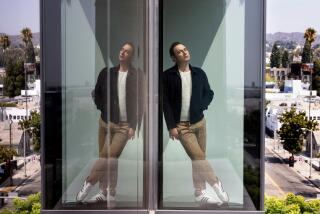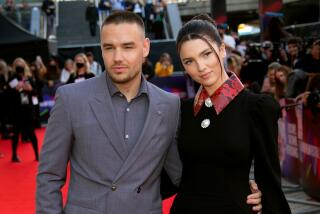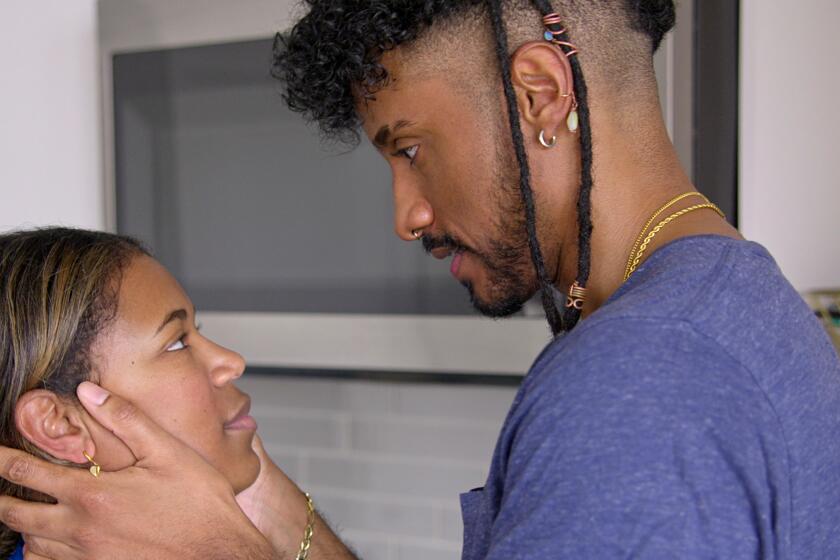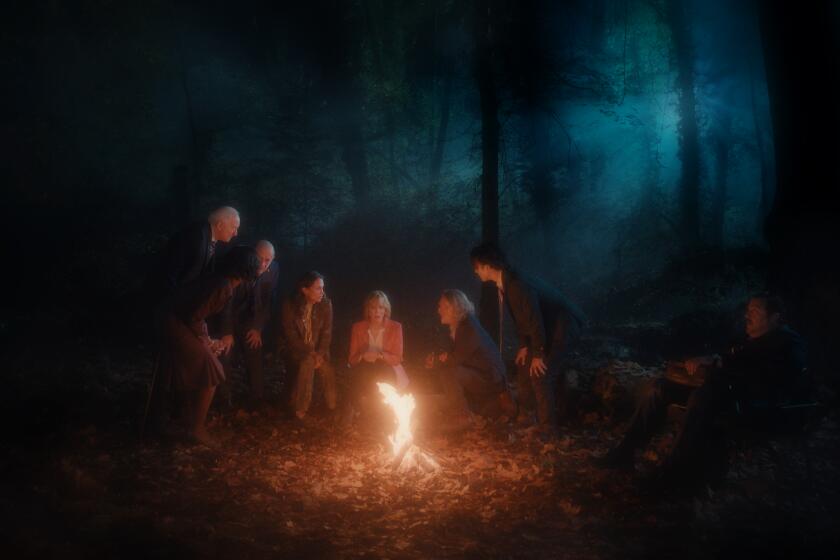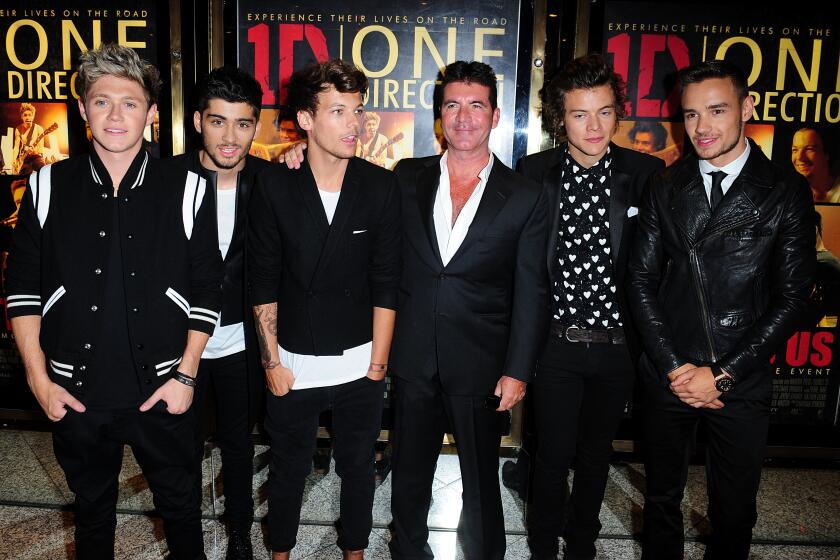Crazy Horse and a Dream Stand Tall
The wind is whipping up a raw chill on the mountaintop, but Casimir Ziolkowski stands defiantly, ready to blast into tons of rock, to burrow his way closer to his father’s dream.
“Fire in the hole!” he shouts, then repeats it twice in rapid succession.
KABOOOHHM!!
A split-second rumble. A flash of fire. A cloud of smoke. Nearly a quarter-million pounds of granite cascade in a thundering avalanche from the base of a colossal stone jaw.
When the dust settles, a somber face emerges, nine stories high.
It’s Crazy Horse, the proud Sioux chief, carved in stone, the first stage in a memorial that will someday embrace the sky at 563 feet and become the largest sculpture on Earth.
It all began 50 years ago thisweek, when a man known by one name, Korczak, single-handedly blasted 10 tons of rock off Thunderhead Mountain.
He had promised to build a monument to the American Indian, and there he was, pushing 40, with little money, starting a job that would consume the rest of his life.
Now others are keeping his word.
More than 8 million tons and 16 years after Korczak’s death, seven of the sculptor’s sons and daughters and his widow, Ruth, are carrying on. On Wednesday, the golden anniversary of that first blast, they will unveil Crazy Horse’s face.
On this blustery spring day, bundled in layers of flannel, a cigarette dangling from his lips, Lilliputian under the 87 1/2-foot-high head, Casimir surveys the blast results like a plastic surgeon checking his handiwork after the bandages are off.
Fifty years down, who knows how many more to go. Fifty? A hundred? Casimir, who has been chipping away since childhood, isn’t counting.
“I figure every day I work, we’re one day closer to being finished,” he says with the calm deliberation of a man who has learned to measure progress in decades. “I don’t have to know where the end is--just that we’re one day closer.”
*
To whittle a mountain into a work of art is like creating a modern-day Sphinx or Colossus of Rhodes. For the Ziolkowskis, that single, seemingly impossible, job has become the family business.
When completed--no one says the word “if” around here--Crazy Horse will sit astride his stallion, his left arm, almost as long as a football field, outstretched, pointing to his Sioux burial grounds.
The memorial will be bigger than the Washington Monument, bigger than the Pyramid at Giza.
So big, in fact, that the four presidential heads on Mt. Rushmore, 17 miles away, could be stacked inside the warrior’s head. So big a five-room house would fit in each of the horse’s nostrils.
Money and nature will determine how many generations this will take, but everyone in the Ziolkowski clan is convinced that one day, perhaps after they are gone, it will be done.
“There’s absolutely no doubt and there never has been--not even a tiny little scintilla,” says Ruth, the girlish 71-year-old widow who guides the carving from a cluttered kitchen table in the log house her husband built.
That attitude can be traced to the always confident Korczak.
“He really believed in what he did and made the people around him believe in it,” says his daughter Monique.
Korczak Ziolkowski (pronounced kor-jock jewel-cuff-ski) was a prize-winning East Coast sculptor who had worked briefly on Mt. Rushmore when he accepted an invitation to create a memorial for the Indians.
“My fellow chiefs and I would like the white man to know the red man has great heroes too,” Chief Henry Standing Bear of the Lakota tribe wrote in seeking his help.
The Indians chose the spot, the sacred Black Hills.
They chose the subject: Crazy Horse, the shrewd tactician who helped lead the charge against Lt. Col. George Armstrong Custer at the Little Bighorn.
Their choice of a sculptor was a Boston-born artist who never took a formal art lesson, a character more flamboyant than any Hollywood screenwriter could invent.
Barrel-chested with broomstick legs, Korczak wore a rakish Don Ameche mustache in youth that later gave way to a Solzhenitsyn-style fringe of beard. He rode his beloved palomino, Warrior, and favored wide-brimmed cowboy hats, leather vests and Western boots.
Korczak was a raconteur who could take six hours (and a steady flow of Manhattans) to answer a single question over lunch, a Renaissance man who loved opera and the symphony as well as a good fight. He was an orphan who fathered 10 children (and delivered one); he played and worked with them, teaching them the rules of baseball as well as the rules of life.
Ruth, who met Korczak when she was 13 and joined him here as a 20-year-old volunteer, describes his ethic. “He said, ‘If you like what you are doing and are happy doing it, work is not a chore.’ ”
He preached tenacity too.
“All our lives we were taught that if you start something, you finish it, or at least you keep working at it,” says Casimir, whose sisters sometimes teasingly call him “Marlboro Man” for his rugged windburn-and-denim look.
Seven of Korczak’s children are trying to finish what he started--but that would rankle the perfectionist in him. “He thought it should be all 10,” Ruth says with a smile. “I think seven is an amazing number.”
The children, mostly in their 30s and 40s, say their father never pressured them to pick up where he left off. But they did, out of dedication and a desire to continue the family legacy.
“Every time I went anywhere, there was no fulfillment, no reason for me being there,” says Casimir, 44, a onetime rebel who dabbled in the oil fields and construction. “I always knew in my heart that this is where I belonged.”
Not that he didn’t have doubts.
“When I was 16 years old,” he recalls, “I was sitting on the edge of what would be the finger [of the memorial] and I thought, ‘This is nuts! There’s nothing but a massive amount of rock. We’ll never be able to do this.’ That was the only time I thought that.”
His father seems to have anticipated this moment of questioning, even if he himself had neither doubts nor regrets.
Korczak persisted with the carving through broken bones, arthritis, four back operations, the removal of six disks and two heart attacks.
And in 1952, he wrote a letter to his children, most of whom had not yet been born. In it, he freed them to go their own way but said that if they stayed with Crazy Horse, it should be for the right reasons.
“The purpose of Crazy Horse is noble,” he wrote in the letter, which is still read at family gatherings.
“There are many people who do not see its nobility at present, and even in your time--and maybe in your children’s time--the vision of Crazy Horse might be clouded to some people; but if you wish to dedicate your life as to carry out my dreams . . . they will then also be your dreams someday.”
*
Today, that dream is being shaped by the hands of the second generation.
Casimir is an explosives engineer who works with the crew of about a dozen that measures, drills and blasts. Most workers are experienced mountain climbers.
Six hundred feet below, his brothers and sisters work in the office, the studio and other parts of this remote compound.
Adam maintains roads and does carpentry. Dawn manages the summer visitors center. Mark heads the timber-management program. Anne is the curator of a growing Indian museum.
Jadwiga, 45, helps run day-to-day affairs and organizes special events at Crazy Horse, which draws more than a million tourists a year.
She left the mountain to attend college in Wyoming, becoming the only child with a diploma, but she too returned.
“I learned enough to know that I didn’t like it,” she says of the outside world. “I believe we are all fortunate we were left with this job.”
Her sister Monique, 37, is a mountain pointer, plotting precise measurements from Korczak’s 1/34th-scale plaster model. These are enlarged, then transferred to the carving.
She is a sculptor too, though she shied away from creating when her father was alive. “He made me too nervous,” she says.
But she always remembers one tip he gave her.
“He said, ‘First you start with a nose in the middle of the face, and the soul comes after,’ ” she recalls. “ ‘You’ve got to put the soul in there.’ ”
Though the Ziolkowski children speak with pride of their father, growing up with a man obsessed with a mountain wasn’t always easy. There were tough times making ends meet--Korczak never took a salary--and at school in town the kids were teased sometimes about their father’s granite dream.
But they were a close-knit family. For a time, they ran a dairy farm and a lumber mill and the children attended a one-room schoolhouse Korczak bought and relocated to the mountain.
They often celebrated birthdays with a unique ritual--pushing a plunger that ignited a blast on the mountain.
And when home became a tourist attraction, everyone from rocket scientist Wernher von Braun to actor Henry Fonda stopped by.
So did Cecil B. DeMille. The director of movie spectaculars, who parted the Red Sea in “The Ten Commandments,” cocked an eyebrow when he saw Crazy Horse and declared: “And I thought what I did was big!”
Too big for one man, surely, but for two decades Korczak worked the mountain alone.
He built a 741-step stairway up the granite walls, hauling 29 tons of lumber on his back, a few planks at a time, sometimes in blizzard conditions.
He hung hundreds of feet above the trees on an inch-thick rope, paintbrush in hand, a bucket of paint attached to his waist, outlining the memorial, with Ruth guiding him from below by army field telephone.
Then he went about the monumental task of blasting, using a small jackhammer and a temperamental compressor.
Korczak refused offers of potential federal funds; no hat-in-hand begging in Washington for him.
But he did eventually accept contributions and charge entrance fees--now $7 per person, $17 per carload. About $22 million has been spent on everything from buying land and equipment to digging wells and paying salaries.
Knowing he could never finish what he started, Korczak planned for his death.
With Ruth’s help, he assembled three spiral notebooks of measurements of the mountain that guide everyone today. And he warned against haste.
“Go slowly,” he said, “so you do it right.”
Above all, he urged, continue without him.
“If this project stops just because I die, my whole life will have been wasted,” he told his family. “I cannot carve Crazy Horse from the grave.”
With his sons, the sculptor hewed out a tomb from a granite outcropping in front of the mountain. He built a pine casket with brass handles. And in 1982, at age 74, he died.
He was buried with his wallet and credit cards. His tomb also has a knocker on the inside--Ruth added one on the outside--and a telephone without wires. “If your father needs to make a call,” a priest told son Adam, “he won’t need wires.”
Many thought Korczak’s death would mean the death of Crazy Horse.
Ruth proved them wrong. She made one deviation from his blueprint, carving the warrior-chief’s head first instead of his horse’s 22-story head. It was the family’s public declaration that the job was going forward.
The family’s plans go beyond the memorial, calling for a university as well as a medical training center for Indians. There’s also a Crazy Horse Memorial Foundation whose scholarship program has given $230,000 to Indian students in the last 20 years.
Ruth, who will soon turn 72, is grandmother of 23 and great-grandmother of four. She hopes that her family will realize Korczak’s dream, working day by day, ton by ton. Even if future generations don’t, the foundation is committed to seeing the sculpture completed.
Each night when she looks out her bedroom window, she can see the finished face of the warrior her husband envisioned when he climbed up the granite crags 50 years ago and drilled four holes into the mountain.
“I don’t think about the future and when it’s going to be done,” she says contentedly. “I’m going to be here 15, 20 years and watch it grow.”
Even when she passes on, she’ll remain on the mountain.
Korczak left room in his tomb for her.
More to Read
The biggest entertainment stories
Get our big stories about Hollywood, film, television, music, arts, culture and more right in your inbox as soon as they publish.
You may occasionally receive promotional content from the Los Angeles Times.

